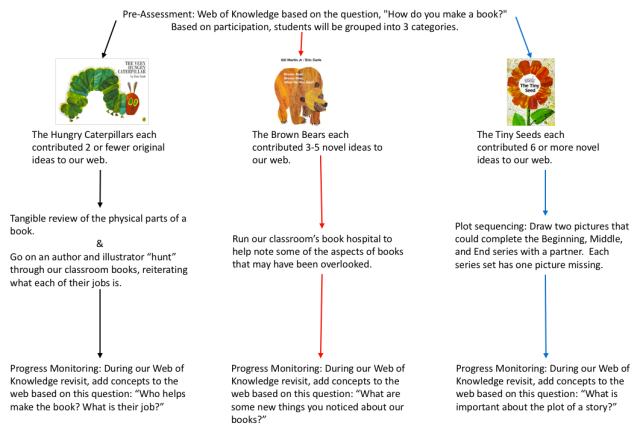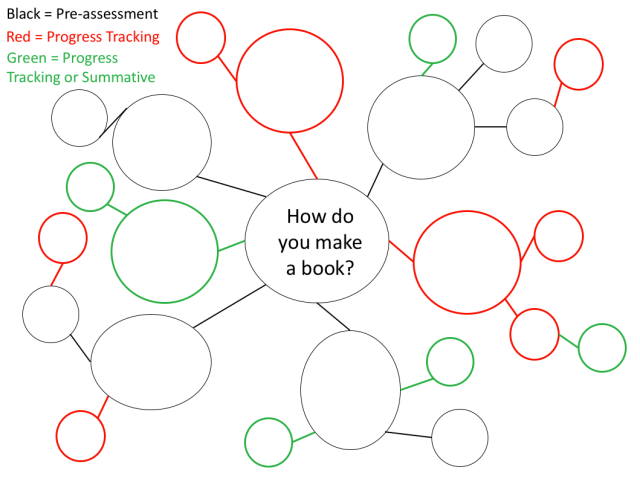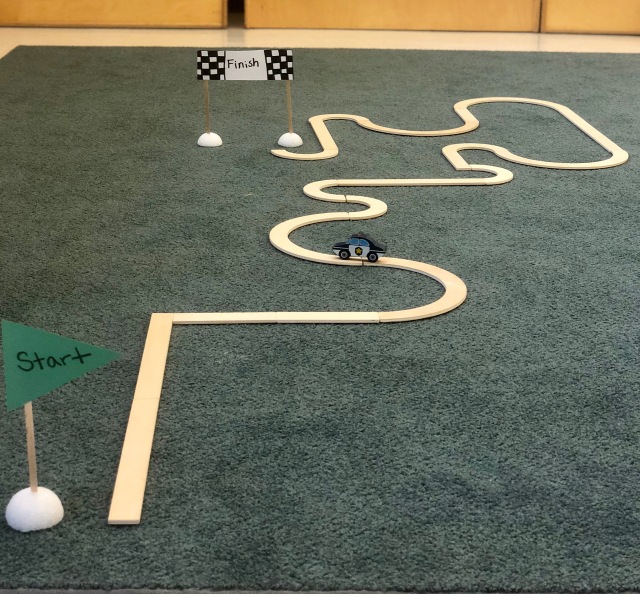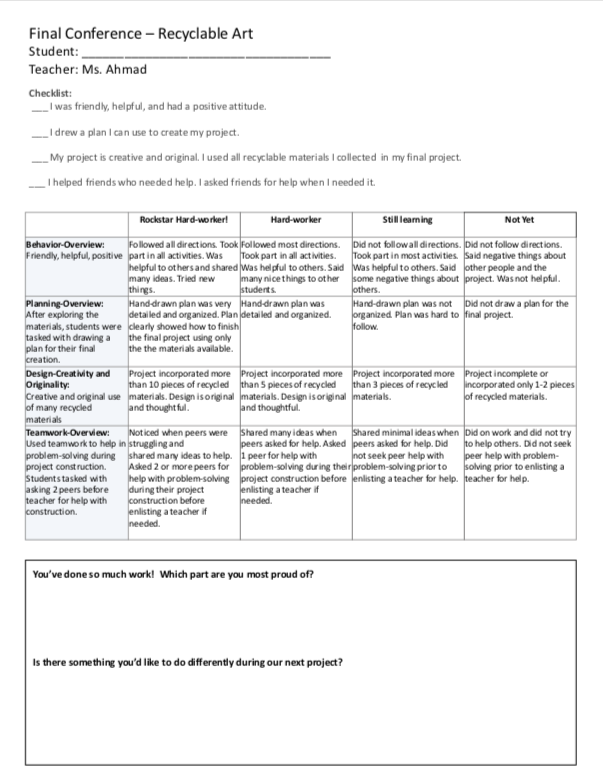-
Recent Posts
Recent Comments
Archives
Categories
Meta
Protected: Demographics and Academic Equity
Posted in Uncategorized
Enter your password to view comments.
Pre-Assessment for Differentiation
Pre-Assessment
For a unit on the publishing process of a book, my students and I will make a Web of Knowledge (also known as a Concept Map) beginning with the question: How do you make a book? This web will work similarly to a more traditional KWL chart in that we will record our ideas and questions and eventually all of the information we’ve learned. We will take a few moments to think about the prompt and then I will invite each child to participate. I will check for students who actively participate and contribute many (6 or more) new ideas, those who contribute a few (3-5) original ideas, and those who contribute very few (0-2) original ideas of their own. The students will be grouped into three groups to begin our unit explorations the next day.

This mind map shows how the children will be grouped following the pre-assessment. For more information on the differentiation activities described in the mind map, please read below! To expand the mind map and view it as a .PDF file, please click here.
Differentiation Activities
The Hungry Caterpillars: Students who contributed 2 or fewer original ideas to our web will be called the Hungry Caterpillars. The Hungry Caterpillars will be instructed to meet me at our community meeting table where we often meet for small group work. I will work with the students to examine books and discuss the physical parts of the book, like the cover, spine, and pages. We will spend some time discussing the roles of the author and the illustrator and spend some time going on an author and illustrator “hunt” on all of our classroom books. Each time we find one, we will be sure to note things like, “We found out that Eric Carle is the author and illustrator. That means he wrote the book and made the pictures.” This repetition and reiteration will serve as an accommodation for ELL and special needs learners who might be unfamiliar with the terminology. The physical touching of the books as we discuss their parts is designed for this purpose, as well. Additionally, I will begin to incorporate other terminology that students in other groups might not be familiar with (like editor or publisher) to allow the Hungry Caterpillars an opportunity to teach their peers.
The Brown Bears: Students who contributed 3-5 novel ideas to our web will be called the Brown Bears. The Brown Bears will be instructed to run our classroom’s book hospital. They will work in small groups of 3 to tape, glue, and add extra paper to make each page look clean, new, and usable. The goal is to have them examine books more closely to observe parts of the book they may have overlooked before.
The Tiny Seeds: Students who contributed many (6 or more) novel ideas to our web will be called the Tiny Seeds. The Tiny Seeds will be instructed to work with a partner in our writing center to complete some plot sequencing tasks. This will be done through pictures so the children can work without a teacher’s guidance. There will be many sets of Beginning, Middle, and End drawings. Each set will be missing one, and the students will be asked to draw 2 possible pictures that could fill in the missing picture. This activity mirrors sequencing puzzles we use, so the children have a basic familiarity with this concept. This activity however, is designed to spark more creativity and critical thinking.
Notes on ELL and Special Education Learners: As stated above, the physical touching of the books while discussing their parts and the repetition and reiteration of new terminology (e.g. author, illustrator) is designed to help ELL and special needs learners who might not be as familiar with this vocabulary. I will have these major vocabulary words translated and available in the native tongue of all students to help their meanings sink in, as well. The needs of a special needs learner will be addressed case by case. For example, if the special need is physical, I might assign a specific buddy to help the student through the physical parts of the task. If the need is visual or auditory, I will carefully locate and suggest the best placement for the student to see or hear myself and other students during our pre-assessment and differentiation activities. If the need is more cognitive, I will use repetition and multi-sensory tangible touching of the books during discussion to help accommodate their needs.
Progress Monitoring
To monitor the progress of all students, we will revisit the Web of Knowledge as a class. I will record the students’ thoughts in a different color to note the difference in the pre-assessment and the current progress monitoring assessment. To differentiate for each group, I will ask each group to add to the discussion in a different way. I will start with the Brown Bears and ask them to first tell the other groups what they did and then to tell us some new things they noticed about the books so we can add it to our web. Next, I will ask the Hungry Caterpillars to tell us about some of the people who help make a book and what their job is. Any ELL and special education learners in this group will be invited to participate verbally as we just spent time learning vocabulary words in English. They will also have the option to draw a response or physically point it out on a book. Finally, I will ask the Tiny Seeds to tell us more about the plot of a story. As a class, we will look at the pictures the Tiny Seeds drew and decide if we could edit or change them in any way to continue and connect all of our learning. Using one series of their drawings, we will work together to author the text, add a title page and page numbers, add a cover with a title, and work to quickly bind the book with a stapler. We will walk through each of these jobs as we are doing it: illustrator, author, editor, and publisher. This brief class activity will allow all of the student groups time to revisit what they each learned, teach other students, and connect the various activities each group worked on.
Notes on ELL and Special Education Learners: As stated above, any ELL and special education learners will be invited to participate in our discussion verbally, through gestures, or through drawing. Just like during the pre-assessment and differentiation activities, the specific needs of a special needs learner will be addressed case by case. This includes anything from physical placement of the student during our progress tracking discussions to assigning a specific buddy to the student to help out with physical tasks.

This is an example of what our Web of Knowledge could look like. The pre-assessment is in one color and each time we revisit to monitor progress, we will write it in a different color.
Posted in Uncategorized
Leave a comment
Test Track

Test Track is a game designed for students of all handwriting levels and abilities. It uses materials from the more traditional Handwriting Without Tears in a novel way. Please click the link below for detailed information about the game’s creation as well as materials and instructions needed to play.
Posted in Uncategorized
Leave a comment
Project Based Learning Assessments
The project I based my Monitoring and Feedback Plan on is one I created for a previous module about Project Based Learning. The project is a multi-project unit on recycling and composting for my pre-K class. This Monitoring and Feedback Plan focuses only on the Recyclable Art project.
Recyclable Art: Project Description
Children will independently explore clean and sanitized recycled materials from our collection. They will be tasked with imagining something they would like to create or build using these materials as they explore them in an open-ended way. Each child will collect at least 10 materials in their own work bin and draw a plan of how they intend to use each of the materials they collected for their creation. When ready, the child can begin to work on their creation using only Tacky glue to hold their materials together. If they run into difficulties creating or executing their plans, they will be asked to ask two peers for help before reaching out to a teacher. When their creation is complete and the glue has dried, the children will be invited to add paint to their creation. The goal of this project is to exercise students’ 21st century skills of creativity, problem-solving, and collaboration. It can be very difficult for children to plan and execute a 3D recycled sculpture when they are often given a flat plane for creativity. Children are encouraged to reach out to peers and eventually a teacher if they need assistance working through a problem. They are also encouraged to notice when a peer might need help and offer suggestions.
Recyclable Art – Student Monitoring and Feedback Plan
Student-Teacher Conferences
This project has three distinct phases to it: open exploration with and collection of recycled materials, drawing a plan for project construction, and constructing the final project. To monitor and provide feedback to students, I will hold a brief conference with each of them after each phase. During the conferences we will go through a checklist for the previous phase. Students will have the option of revisiting the previous phase until the checklist can be completed. I will also ask a few open-ended questions to check-in about their plans for the next phase. Below you will find the checklists, questions, and student reminders for the first two conferences.
Post-Collection Conference
___ I have collected at least 10 materials to use.
___ I have ideas for using each material that I collected.
Do you have any ideas for what your final creation might be? What are they?
Now that you’ve explored and collected your materials, what is the next step?
Reminder: While you are drawing your own plan, please remember to offer help to any friends who you think might need it. If you need some help, please remember to ask two friends first. Then, you can ask me!
Post-Planning Conference
___ I have drawn a plan for my final creation.
___ I have used all of the materials I collected in my plan.
___ I offered help to friends.
___ I asked friends for help if I needed it.
___ I feel ready to begin my final creation.
At our last conference, you thought your final creation might be_______________________. After drawing it out, what is the plan for your final creation?
Now that you’ve drawn your plan, what is the next step?
Reminder: While you are constructing own project, please remember to offer help to any friends who you think might need it. If you need some help, please remember to ask two friends first. Then, you can ask me!
Final Conference
The final feedback conference will be a bit different than the previous two. First, we will go through their final checklist. Next, we will go through my rubric. While we go through my rubric, I will show them documented evidence of my feedback. For example, when going through the planning portion of my rubric, we will look at the actual hand-drawn plan as evidence. Other examples of documented evidence will be photos of collaboration and helping one another, direct quotes from the students, recordings of their conversations, and anecdotal stories of their interactions, as well. This evidence will be presented and displayed alongside their final creations in our gallery. The form containing the checklist, rubric, and questions for the final conference can be found below. The rubric was created using the Rubric Maker from Teach4Learning, Inc.

To open this rubric as a .pdf, please click here.
Posted in Uncategorized
Leave a comment
Formative Assessments in My Pre-K Classroom
I work with pre-Kindergarten students ages 3-5. As a result, my formative assessments have been mostly anecdotal and documentation style. When I refer to documentation of children’s learning, I’m referring to the art of closely observing the children, taking notes on which materials they are using and how, writing down direct quotes, photographing them in action, and studying samples of their work. It can be very labor intensive, but to me it feels like such important work! I teach mainly to help strengthen children’s fine and gross motor and social-emotional skills. Documentation of their work and interactions helps me to see where they are and where I need to get them to in terms of these skills. Documentation easily lends itself to making the children’s learning visible in order to analyze it and share it with other students, families, and our broader learning community. Documentation is dear to me and really drives my passion for teaching! Please click the images below to see two examples of visible documentation in my classroom.
Documentation aside, I use other formative assessments in my work. I often play a song game that requires children to not only recognize their own written name, but that of their peers. We might do a similar game with simply letters and letter sounds. I like playing these games as a whole group so the students can learn from one another. I’ve noted that there are certain students who always shout out the answer first. Through research, I have modified this assessment with the Popsicle Stick method to help me randomly give all students the opportunity to participate more equally (Classroom Techniques, 2012).
While I use playful assessments like the one mentioned above every day in my classroom, research and discussions with my cohort have shown me that I need to make a few modifications. For example, I need to begin incorporating more assessments that give me data or a written record. To gather data, I sometimes use a Web of Knowledge. My web starts with a simple question and serves as a diagnostic assessment before it is a formative assessment. After working through our project or topic of study for some time, we revisit our web and add to it using another color of marker, noting the date. This is where it becomes a formative assessment as it allows me to see what the children have comprehended and taken away from our studies.

An example of what a Web of Knowledge could look like with different colors representing each revisit of the web.
Simply put, my goal for using formative assessments is to track data and allow me to see if my lessons are clear and meaningful to students. One must change and modify their assessments if they are not producing trackable data. Something discussed in the video PLCs at Work: Analyzing and Using Formative Assessment Data really spoke to me; the idea that the data you collect is not about you as a teacher. It is about student learning and what you choose to do with it is a reflection of professionalism not skill. Trackable data can be intimidating, but it does not mean you did anything wrong, but rather that you know what you need to do next!
____________________________________________________________________________________________
References
CLAS Network [Username]. (2015, November 30). PLCs at Work: Analyzing and Using Formative Assessment Data [Video File]. Retrieved from https://www.youtube.com/watch?v=buUaPW1uhSE&feature=youtu.be
Classroom Techniques – Formative Assessment Technique Number One. (2012, August 28). Retrieved from https://www.nwea.org/blog/2012/classroom-techniques-formative-assessment-technique-number-one/
Posted in Uncategorized
Leave a comment


